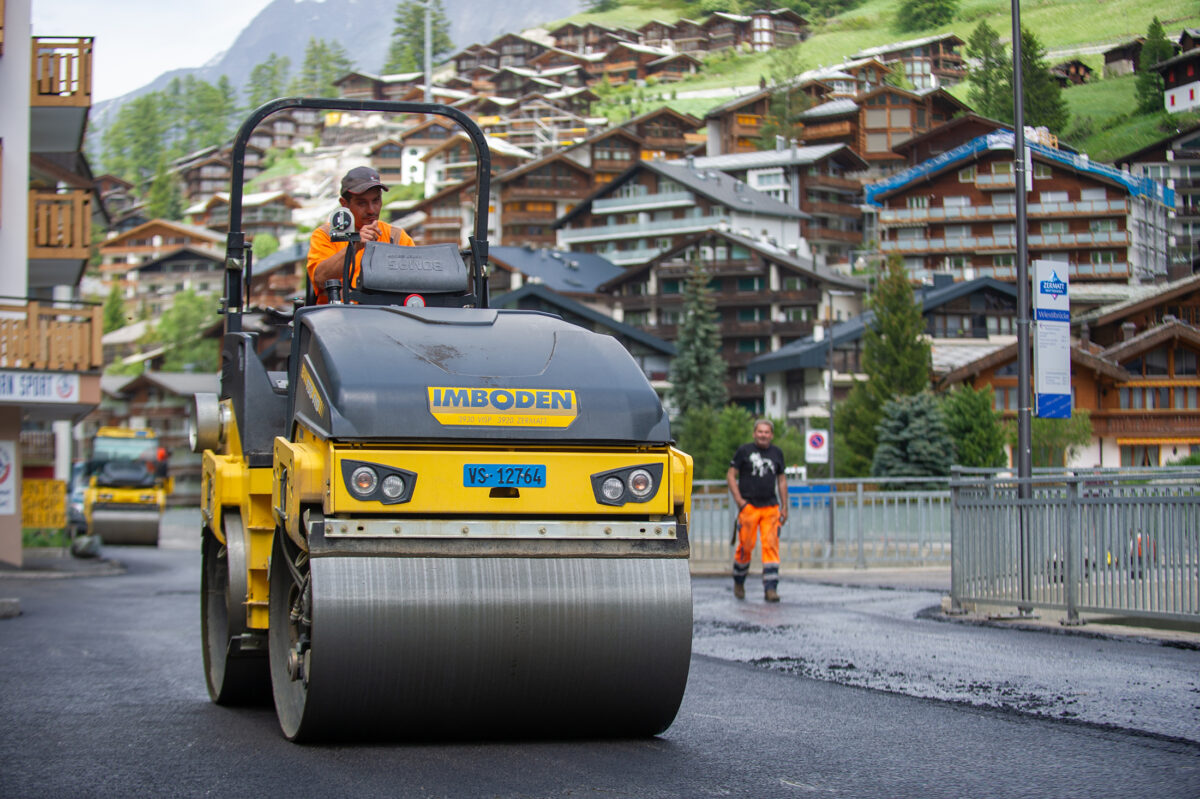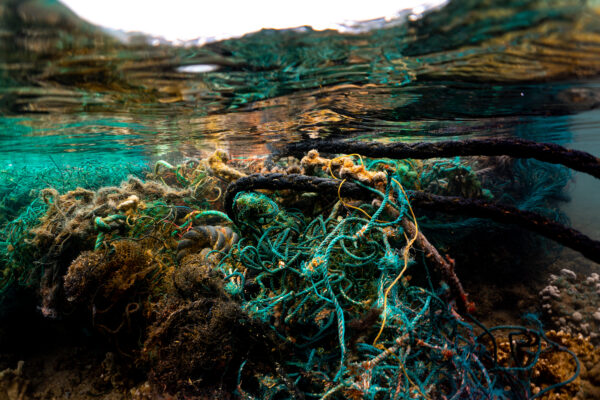Paved With Good Intentions: Plastics Waste Gets New Life as Asphalt Additive

Plastics waste gets new life and positive reviews as an asphalt additive for roads and other hard surfaces
The use of waste plastics as a paving material offers environmental benefits. The most obvious is that it can take tons of single-use plastics out of the waste stream and embed them into durable, long-term applications. An additional yet lesser-known benefit is that it helps to reduce asphalt pollution.
Asphalt is basically made of bitumen and stone. Matt Powers, editor-in-chief of Green Builder, wrote in November 2022 that “At certain temperatures, such as when it is first put down, asphalt gives off toxic pollutants. In fact, some estimates put that pollution in excess of particles emitted by gas vehicles.” The article cited a California study published in Science Advances which concluded that “asphalt could be a long-lasting source of pollution.”
Bitumen represents about 10 percent of the typical asphalt mix, but it’s the petroleum-based, intensive component of asphalt, and when heated to a certain level it releases toxic pollutants. Research suggests that replacing bitumen with waste plastics in the mix mitigates that issue.
Two Primary Processes

Research biologist Dr. Jennifer Lynch is helping to lead the effort to repurpose plastics waste in asphalt in Hawaii. Courtesy of Katy Shaw
In general, there are two methods of incorporating recycled plastics in asphalt: the wet process and the dry process, notes the Greenbelt, Md.-based National Asphalt Pavement Association (www.asphaltpavement.org). NAPA provides a thorough overview of key factors and research in this area in an October 2020 report called “Recycled Plastics in Asphalt, Part A: State of the Knowledge” (https://tinyurl.com/RecycledPlasticsinAsphalt).
In the wet process, the report explains, recycled plastics are added into the asphalt binder as polymer modifiers or asphalt replacement (in some cases, erroneously referred to as asphalt extenders), where mechanical mixing is required to achieve a homogeneous modified binder blend. Recycled plastics with low melting points, such as linear low-density polyethylene (LLDPE), low-density PE (LDPE) and high-density PE (HDPE), are typically suitable for this process. For the wet process, the loading of recycled plastics commonly reported in literature varies from approximately 2 to 8 percent by weight of asphalt binder in a ton of mixture. This level corresponds to about 2 to 8 pounds.
In the dry process, the NAPA study continues, recycled plastics are added directly into the mixture as either aggregate replacement, mixture modifiers, binder modifiers or any combination thereof. The aggregate replacement approach is commonly used with recycled plastics with a high melting point (i.e., above the typical production temperature of asphalt mixtures), such as polypropylene (PP), PET, polystyrene and polycarbonate, while the mixture modifier approach is applicable to virtually all types of recycled plastics except PVC due to concerns about hazardous chloride emissions.
When recycled plastics with a melting point below the mixture production temperature (e.g., polyethylenes) are used for mixture modification via the dry process, they will melt upon mixing with the hot aggregates and produce plastic-coated aggregates with potentially improved physical and surface characteristics.
Previous experience of asphalt contractors in France indicated that when LDPE was added into the asphalt mixture via the dry process, part of the plastics coated the surface of aggregate particles while the rest was dispersed in the asphalt mortar phase. For the dry process, the dosage of recycled plastics commonly reported in literature varies from roughly 0.2 to 1 percent by weight of aggregate, which corresponds to about 4 to 19 pounds of recycled plastics in a ton of asphalt mixture.
So, the authors extrapolate, “If we assume that there are 38 million tons of LDPE or HDPE waste available per year, more than 10 percent of every asphalt mixture would need to be plastic to consume all the LDPE and HDPE waste in the U.S.”
Active in Scotland
MacRebur Ltd. (www.macrebur.com), of Lockerbie, Scotland, calls itself “The plastic road company.” Officials explain that its products are made from non-recyclable waste plastics that were destined for landfill or incineration. Its products are used as binder extenders and/or modifiers to reduce the volume of bitumen required in an asphalt mix. Further, it states that independent laboratory testing has demonstrated that MacRebur products, dubbed MR6 and MR8, do not leach plastics or generate toxic fumes.
Additionally, the firm says various labs have confirmed that its products significantly improve the stiffness and deformation resistance of asphalt while avoiding the embrittlement of oxidization, evidenced by increased fracture toughness and fatigue life.
“With each kilometer (0.6 miles) of road laid using our MR products, we use up the equivalent weight of 684,000 bottles or 1.8 million one-time-use plastic bags.” the 7-year-old company says on its website. “One [metric ton] of MacRebur mix contains the equivalent of 80,000 plastic bottles.”
MacRebur says it has patents pending and contracts with countries around the world. Roads have been constructed using its materials in the U.S., Australia, Turkey, Bahrain, Slovakia and New Zealand, and are now being set up in South Africa.
The company adds that the plastics waste it collects comes from about 60 percent commercial sources and 40 percent from households.
“We then use a granulator to turn this into small pieces of no more than 5mm,” the company explains. “Next, the plastics granules are mixed with our activator—it’s this that makes the plastic bind properly into our roads. Our activator is patented and what’s in it is a secret. This blend of plastics granules and the activator—let’s call it the MacRebur mix—then goes to an asphalt producer.”
Since making asphalt requires heat, usually around 180°C (356°F), the company says it makes sure that all the plastics it uses melts at a temperature lower than this—around 120°C (248°F)—so it homogenizes properly without creating microplastics. This is why MacRebur says it uses “a carefully selected range of polymers” in all its products. It says its mix has been used successfully in asphalt on motorways, roundabouts (i.e., traffic rotaries), car parks, airport runways and racetracks.
MacRebur says its plastics roads look the same as typical asphalt but, because they contain plastics, are more flexible, allowing them to cope better with the expansion and contraction caused by changes in the weather.
Reusing Face Masks
Meanwhile, there are pilot projects taking place with different approaches to using polymer waste in paving materials. A couple of years ago during the pandemic researchers in Australia reported on using discarded face masks and single-use surgical masks in a composite mix together with recycled concrete aggregate (RCA) derived from waste concrete and other minerals from demolished buildings. They were used in RCA for road base and sub-base applications.
With shredded masks comprising about 2 percent of the mix, the resulting material was found to be ideal for two of the four layers usually required to make roadways. Researchers reported on the project in the May 15, 2021, issue of the journal Science of the Total Environment (https://tinyurl.com/FaceMasksInPavement).
The PP from the surgical masks helped to reinforce the bindings of the rubble particles while increasing the flexibility and durability of the road surface. The researchers in Melbourne reported that paving a kilometer of two-way road with the RCA and 3 million face masks would result in a rerouting of 93 tons of waste from landfills.
Last summer, the Good News Network reported that engineers at RMIT University in Australia had discovered that adding rubber from used tires to the bitumen in asphalts “acts like sunscreen for roads” and halves the rate of sun damage. The experimental bitumen blend is said to be UV-resistant while also withstanding traffic loads. The potential result could save governments millions of dollars on road maintenance annually. The findings were reported in May 2022 in the Journal of Cleaner Production (https://tinyurl.com/RubberInRoads).
Other Approaches

In Hawaii they use derelict fishing gear, such as this clump retrieved from a coral reef in Oahu, as a source for plastics waste in paving projects. Courtesy of Rachel Sandquist
In the U.S., pilot programs in Missouri, Pennsylvania, Virginia, California and Hawai’i have been experimenting with using various types of plastics waste—from used printer cartridges and plastic bottles to single-use bags—in aggregate materials for asphalt road mixtures.
The Pew Charitable Trusts reported that in May 2022 the California Department of Transportation (Caltrans) tested an asphalt mixture that contains 10 percent recycled plastics from printer ink cartridges on a shoulder of Highway 99 in Elk Grove, near Sacramento.
The pavement looked and performed better than expected after several months, with no signs of cracking or rutting, a Caltrans spokesman reported. That led the department last August to expand the test by using the mix to pave all lanes in a 500-foot section of the highway.
The Hawaii Department of Transportation (HDOT) reported last fall that it was testing an asphalt mix with recycled plastics as part of its sustainable transportation initiatives. The plastics road pilot took place last October on a 2.2-mile stretch of Fort Weaver Road on Oahu, west of Honolulu. HDOT said that the 1,950 tons of plastics-modified asphalt used in the pilot will keep the equivalent of 195,000 plastics bottles out of landfill.
“Using plastic in our asphalt has the potential to make our roads stronger and upcycle material that would be otherwise headed for a landfill,” said Deputy Director for Highways Ed Sniffen. “Even though we’re using a material that has been used on roads in the United States for over five years, we need to make sure the mix is right for Hawaii and our environment.”
As part of the pilot, the department contracted with two universities to evaluate the performance of the modified asphalt and the potential of the material to release microplastics into its surroundings. The evaluation will take place over a year and a half and HDOT says it will share the results of the evaluation with the public and the legislature (see https://tinyurl.com/HDOT-asphalt-testing).
Dr. Jennifer Lynch, a research biologist in the Chemical Sciences Division of the National Institute of Standards and Technology and co-director of the Center for Marine Debris Research (CMDR) at Hawaii Pacific University, spelled out the goals in an online post. She is the co-principal investigator on the project in Hawaii and wrote last October that she had spent 18 months learning about asphalt roads and especially how they are paved in the state.
“As a marine environmental toxicologist,” she said, “I joined this project because the information I learned convinced me that repurposing waste plastics into roads has a good chance of being an environmentally friendly recycling option.”
She wrote that HDOT could use 40 tons a year of waste plastics in asphalt roads alone and noted that close to that amount of HDPE could be sourced from the recovery of trawl nets (also known as derelict fishing gear, or DFG). “CMDR plans to repurpose DFG into Hawaii’s roads, not single-use plastics. Our plan is not to create an excuse for producing and using more single-use plastics.”
The grand challenge in recycling waste plastics into asphalt is to improve the mechanical performance of the road while not causing more pollution, Lynch added.
“The key is chemical engineering—finding the right type and percentage of compatibilizing chemicals that allow the plastics to homogeneously mix with binder and flow at the same viscosity. Solving this chemical puzzle will encourage the use of a more environmentally friendly wet process, in which plastics are melted with the liquid binder before being mixed with aggregate. This should result in no microplastics leaching from the pavement.
“The logistically easier dry process,” Lynch wrote, “could lead to microplastic leaching because the plastics are mixed with the heated aggregate before being mixed with binder. Experimenting with different compatibilizing chemicals is the current bottleneck for plastics recycling in asphalt.”
Looking Ahead
These are just a few of the pilot projects being undertaken nationwide and beyond, as governments and organizations look to find creative ways to repurpose waste plastics in a meaningful way, with positive results.
In its report, NAPA concluded: “While significant effort has gone into understanding the impacts of recycling plastics in asphalt, more research is required by the asphalt, plastics and petrochemical industries in order to advance the infrastructure of low-cost recycling of plastics. There is no silver bullet, but patience, partnership and open communication are essential to determine if plastics in asphalt can be the next great recycling story.”
